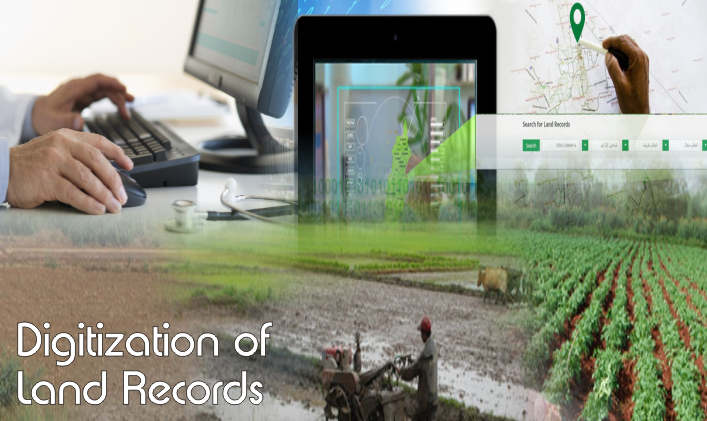Digitalization of Jamabandies
Jamabandi is an essential document which contains all the information of various categories of land along with different survey numbers
Post by MOHD AMIN MIR on Friday, September 30, 2022

Revenue department is the oldest and an important one. This department is understood as synonymous with LAND and maintenance of records of the same thereof. Land is divided into various categories depending on the use it is put into. Some of the categories are Agricultural, Non-agriculture, Banjri jaded, Bangri Qadeem, etc. The department maintains the records of these distinct types of land category-wise. JAMABANDIES, GIRDAWARIES, Mutation registers and Fardi portal are well heard of. People throng tehsil offices to get the documents or information related to their holdings. The basic soldier of revenue department, Patwari, maintains and updates these records thereby making it available for reference to the government and general public.
Jamabandi is an essential document which contains all the information of various categories of land along with different survey numbers. A survey number is a fixed number given to a fixed piece of land during settlement in an estate. Reading of Jamabandi register is a very specialized task and requires a vast knowledge and expertise thereby rendering it a forte of few skilled revenue officials.
Jamabandi is also called “Char Sala” meaning it being written and re-written after a time period of four years. The mutations attested from the preparing of previous Jamabandi of an estate are incorporated in the Remarks column of that Jamabandi with red ink as these entries become visible and entries in the Khanakast are tallied with the current Girdawari. Jamabandi Form has twelve columns where each column depicts unique information.
Most of these Jamabandies were prepared in the year 1969-71 before the commencement of Agrarian Reforms Act. Then, after a gap of twenty years new Jamabandies were prepared in all estates of the erstwhile state. The process continued till 1999.The then officials compiled these Jamabandies but most of them were left unchecked and remain without the signatures of attesting authorities. This unattested record gave birth to litigations, on the one hand and, left a scope for embezzlement, on the other hand.
Again after a gap of almost thirty years Land Records Information System was launched in the year 2017 entitled ‘Aap Ki Zameen Aap Ki Nigrani’ under the Digital India Land Records Modernization Programme. Under ‘Digital India’ Mission various initiatives were taken across sectors to digitalize records. Same was done with zeal and enthusiasm by the Jammu and Kashmir administration. The already available land records were scanned by the revenue department in collaboration with Ram Tech Company. This marks a complete transition from offline to online. Now people can check the records of their land online from anywhere. This has decreased rush in Central and District Record Rooms and Tehsil Offices.
The information of land records especially recently prepared Jamabandies are made available to the people thereby making access easy. Before digitization manual processing was tedious. By digitizing new Jamabandies, transparency and fairness would be achieved. It will also help the revenue department to shift their workforce and attention towards other urgent issues, for instance, Settlement.
Recently digitized Jamabandies are well documented and would hence boost revenue departments digital footprint and audience. As already mentioned, Jamabandies are reviewed and updated after every four years. However, this prescription was not followed in the past and hence most of these were not in line with the current ground reality. The changes in title and interests of the estate coming into the notice of revenue department were not reflected in these Jamabandies when these were subject to reverification at Regional Director Land Records Office. Now these Jamabandies got reverified at RDLR Office and were cross-checked by patwaris to minimize errors.
It was ordered that before final digitization the scanned printouts shall be handed over to revenue authorities at the Tehsil level and will be read before Zamindars for cross-check of entries in Khanna Milkiyat, Khanna Kasht, Survey number, area involved and essentially updation of mutations. Before digitizing any record, it is important on the part of concerned authorities to have widespread consultation with different stakeholders. In this case of Jamabandies, taking Zamindars and land-owners onboard along with Chowkidars and Lumberdars would help verify the entries.
India is mostly a rural country. People are not aware of e-services as digital divide is high. Wrong entries in Jamabandi would give rise to endless worries for these rural folks. It would make them run from pillar to post to get their record corrected and consequently would render them vulnerable and helpless. This is so because once government is over with any project and the completion takes place then the onus lies on people who have been erred to get their grievance redressed. This is exactly what happened in Tamil Naidu where digitization was riddled with mass errors. The complainants, to whom the obligation to get their names etc., corrected had shifted, found it absolutely difficult and cumbersome. So, to their rescue an order was issued by Tamil Naidu government which called for extensive exercise to correct the details. What should follow completion of digitization is means to get wrong entries, if any, corrected.
(The Author is Incharge District Record Room Anantnag at Deputy Commissioner Office Anantnag. Email: mohdaminmir9@gmail.com)